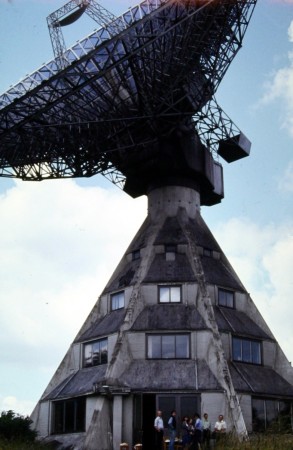 58/87, 1982-06-26. Participants in the student practical in radio astronomy are congregated on the loading ramp.
58/87, 1982-06-26. Participants in the student practical in radio astronomy are congregated on the loading ramp.
|
 101/18, 1985-05-27. Located at the summit of the Stockert, the radio telescope is visible from a large distance. This picture was taken from the Hartenberg, 5 km east of the Stockert. The 10 metre dish also just visible in the clearing of the forest.
101/18, 1985-05-27. Located at the summit of the Stockert, the radio telescope is visible from a large distance. This picture was taken from the Hartenberg, 5 km east of the Stockert. The 10 metre dish also just visible in the clearing of the forest.
|
 104/26, 1985-06-23. In the foreground is one of the counterweight arms (bottom right) and part of the dish (top right). This is the view west-south-west from the platform behind the mirror. This platform rotates with the dish when the telescope is moved in azimuth.
104/26, 1985-06-23. In the foreground is one of the counterweight arms (bottom right) and part of the dish (top right). This is the view west-south-west from the platform behind the mirror. This platform rotates with the dish when the telescope is moved in azimuth.
|
 104/29, 1985-06-23. The 25 metre telescope from an unusual angle.
104/29, 1985-06-23. The 25 metre telescope from an unusual angle.
|
 105/19, 1985-07-25. During the summer the whole Radioastronomisches Institut der Universität Bonn - which own the Stockert - will drive out there for a barbecue. Here we see a few of the participants of such a Stockertfest, including the radio telescope itself.
105/19, 1985-07-25. During the summer the whole Radioastronomisches Institut der Universität Bonn - which own the Stockert - will drive out there for a barbecue. Here we see a few of the participants of such a Stockertfest, including the radio telescope itself.
|
 105/37, 1985-07-25. Here the Sun is obscured by the secondary mirror of the telescope.
105/37, 1985-07-25. Here the Sun is obscured by the secondary mirror of the telescope.
|
 101/23, 1985-10-25. The telescope from the front. This view - with the mirror pointing southeast - is quite rare. The park position points northwest and regular observations are made in the meridian - looking due south.
101/23, 1985-10-25. The telescope from the front. This view - with the mirror pointing southeast - is quite rare. The park position points northwest and regular observations are made in the meridian - looking due south.
|
 101/24, 1985-10-22. The telscope from behind. This is the title picture for the article about the 30th anniversary.
101/24, 1985-10-22. The telscope from behind. This is the title picture for the article about the 30th anniversary.
|
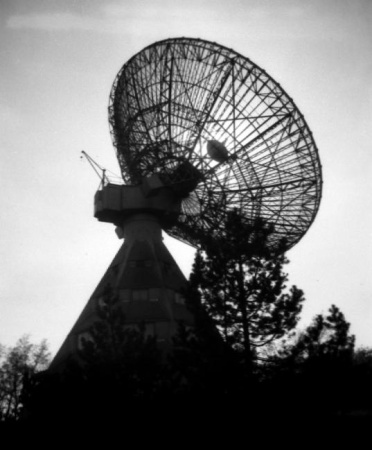 122/36, 1988-05-11. Here the Sun is obscured by the secondary mirror of the telescope.
122/36, 1988-05-11. Here the Sun is obscured by the secondary mirror of the telescope.
|
 172/34, 1999-08-18. The telescope in 1999.
172/34, 1999-08-18. The telescope in 1999.
|
 58/03, 1982-06-26. The 25 metre telescope is controlled by the Argus processor in the foreground. Data acquisition is already done by a modern system based on microcomputers.
58/03, 1982-06-26. The 25 metre telescope is controlled by the Argus processor in the foreground. Data acquisition is already done by a modern system based on microcomputers.
|
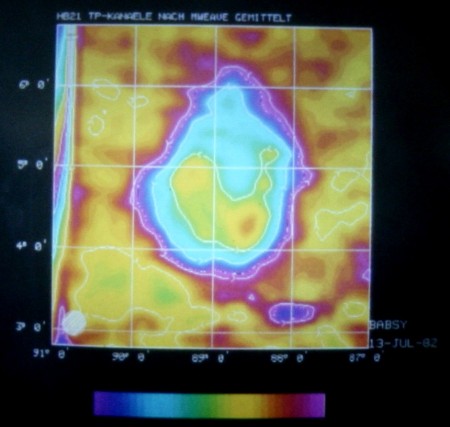 58/17, 1982-07-13. The data from the 25 metre telescope are written to reel-to-reel magnetic tapes and transported to Bonn. There the Radioastronomisches Institut - which owns the Stockert - has a modern data processing system, where the final map can be displayed on a colour monitor.
58/17, 1982-07-13. The data from the 25 metre telescope are written to reel-to-reel magnetic tapes and transported to Bonn. There the Radioastronomisches Institut - which owns the Stockert - has a modern data processing system, where the final map can be displayed on a colour monitor.
The data processing system is based on that of the Starlink network in the United Kingdom. The main computer is a Digital VAX 11/780 with VMS operating system. A number of text terminals (VT100) are connected to this by serial lines. The colour display is controlled by subsidiary Sigma/ARGS computers. BABSY (Bonner Astronomisches Bildverarbeitungs SYstem) is based both on Starlink software and on software from the neighbouring Max Planck Institut für Radioastronomie.
|
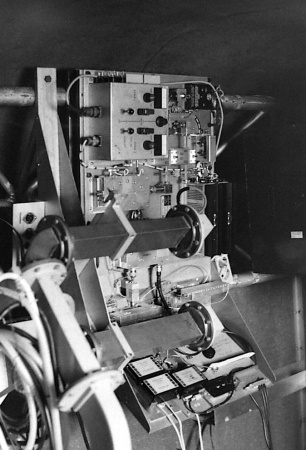 101/19, 1985-05-27. The cabin with the frontend receiver is situated behind the primary mirror. The cabin tilts along with the primary mirror when the altitude of the telescope changes. The waveguides come directly from the receiver horn and guide the two polarised signals into the electronic circuits, where the first amplification takes place.
101/19, 1985-05-27. The cabin with the frontend receiver is situated behind the primary mirror. The cabin tilts along with the primary mirror when the altitude of the telescope changes. The waveguides come directly from the receiver horn and guide the two polarised signals into the electronic circuits, where the first amplification takes place.
|
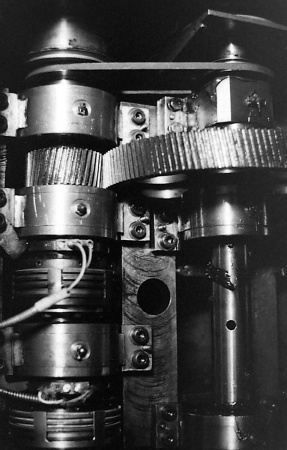 101/20, 1985-05-27. The axis cross of the mirror rests on the pyramid-shaped building. The azimuth axis stretches vertically through the whole building. About halfway up a lid can be opened to see part of the gearbox for the azimuth drive.
101/20, 1985-05-27. The axis cross of the mirror rests on the pyramid-shaped building. The azimuth axis stretches vertically through the whole building. About halfway up a lid can be opened to see part of the gearbox for the azimuth drive.
|
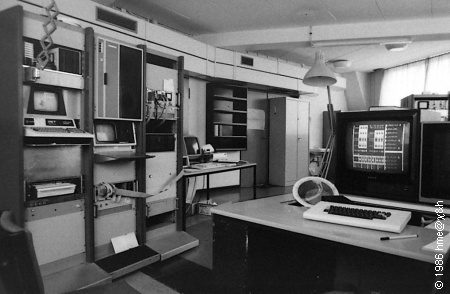 101/21, 1985-05-27. The 25 metre telescope is controlled by a microcomputer. Front right are merely the keyboard and large monitor; the computer is in the second rack below the magnetic tape unit. In 1982 this computer would control only the data acquisition. This picture is part of the article about the 30th anniversary, which has a more comprehensive description.
101/21, 1985-05-27. The 25 metre telescope is controlled by a microcomputer. Front right are merely the keyboard and large monitor; the computer is in the second rack below the magnetic tape unit. In 1982 this computer would control only the data acquisition. This picture is part of the article about the 30th anniversary, which has a more comprehensive description.
|
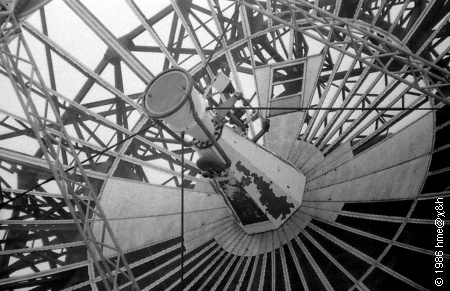 106/10, 1986-02. The 25 metre mirror is a Cassegrain system. The radio waves are concentrated by the primary mirror in the primary focus. However, the wave do not get that far, because the secondary mirror reflects tham back to the secondary focus. This is inside the large receiver horn. This picture is part of the article about the 30th anniversary, which has a more comprehensive description.
106/10, 1986-02. The 25 metre mirror is a Cassegrain system. The radio waves are concentrated by the primary mirror in the primary focus. However, the wave do not get that far, because the secondary mirror reflects tham back to the secondary focus. This is inside the large receiver horn. This picture is part of the article about the 30th anniversary, which has a more comprehensive description.
|
 106/15, 1986-02-20. The coordinate transformer seen from the front. In the beginning, the conversion from celestial coordinates (right ascension and declination) into telescope coordinates (azimuth and altitude) was performed mechanically. This picture is part of the article about the 30th anniversary, which has a more comprehensive description.
106/15, 1986-02-20. The coordinate transformer seen from the front. In the beginning, the conversion from celestial coordinates (right ascension and declination) into telescope coordinates (azimuth and altitude) was performed mechanically. This picture is part of the article about the 30th anniversary, which has a more comprehensive description.
|
 106/17, 1986-02-20. The coordinate transformer seen from the front. In the beginning, the conversion from celestial coordinates (right ascension and declination) into telescope coordinates (azimuth and altitude) was performed mechanically. A similar picture is part of the article about the 30th anniversary, which has a more comprehensive description.
106/17, 1986-02-20. The coordinate transformer seen from the front. In the beginning, the conversion from celestial coordinates (right ascension and declination) into telescope coordinates (azimuth and altitude) was performed mechanically. A similar picture is part of the article about the 30th anniversary, which has a more comprehensive description.
|
 122/34, 1988-05-11. Occasionally it is possible to climb through the claustrophobic receiver cabin into the main dish. Here we see the "Indianerzelt" (tipi), as the enclosure beneath the receiver horn is called.
122/34, 1988-05-11. Occasionally it is possible to climb through the claustrophobic receiver cabin into the main dish. Here we see the "Indianerzelt" (tipi), as the enclosure beneath the receiver horn is called.
|
|
 58/87, 1982-06-26. Participants in the student practical in radio astronomy are congregated on the loading ramp.
58/87, 1982-06-26. Participants in the student practical in radio astronomy are congregated on the loading ramp.
|
 105/19, 1985-07-25. During the summer the whole Radioastronomisches Institut der Universität Bonn - which own the Stockert - will drive out there for a barbecue. Here we see a few of the participants of such a Stockertfest, including the radio telescope itself.
105/19, 1985-07-25. During the summer the whole Radioastronomisches Institut der Universität Bonn - which own the Stockert - will drive out there for a barbecue. Here we see a few of the participants of such a Stockertfest, including the radio telescope itself.
|
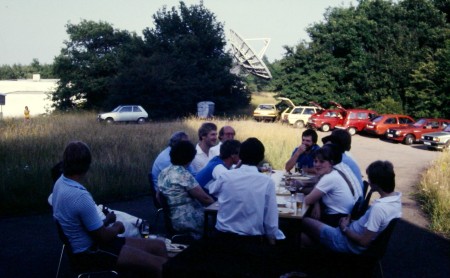 105/31, 1985-07-25. During the summer the whole Radioastronomisches Institut der Universität Bonn - which own the Stockert - will drive out there for a barbecue. Parking can be at a premium on such occasions.
105/31, 1985-07-25. During the summer the whole Radioastronomisches Institut der Universität Bonn - which own the Stockert - will drive out there for a barbecue. Parking can be at a premium on such occasions.
|
 105/33, 1985-07-25. Here, the daughters of one of the astronomers are flying a kite (Drachen in German). This is proper work, as the "Draco Cloud" is one of the main research topic at the Radioastronomisches Institut in these years.
105/33, 1985-07-25. Here, the daughters of one of the astronomers are flying a kite (Drachen in German). This is proper work, as the "Draco Cloud" is one of the main research topic at the Radioastronomisches Institut in these years.
|
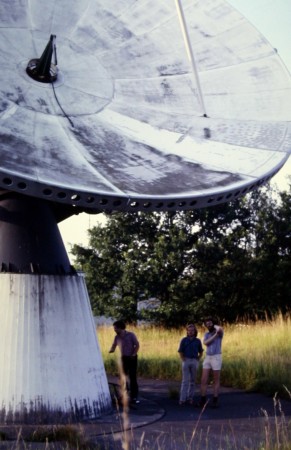 105/39, 1985-07-25. The 10 metre dish with three PhD students for scale.
105/39, 1985-07-25. The 10 metre dish with three PhD students for scale.
|
 104/24, 1985-06-23. The road from the left and uphill leads past the Sonnenhaus ("house of the Sun", control building for the 10 metre dish for solar observations) to the 25 metre main telescope. In this picture the guest house - with space for half a dozen or more observers and technicians - is behind us and a regular house is beyond the right edge of the frame. This picture reminds me of the melancholy, when I would tiredly crawl out of bed just before midday. Often the weather would not be as clear as the evening before, and a day's work in Bonn would lie ahead.
104/24, 1985-06-23. The road from the left and uphill leads past the Sonnenhaus ("house of the Sun", control building for the 10 metre dish for solar observations) to the 25 metre main telescope. In this picture the guest house - with space for half a dozen or more observers and technicians - is behind us and a regular house is beyond the right edge of the frame. This picture reminds me of the melancholy, when I would tiredly crawl out of bed just before midday. Often the weather would not be as clear as the evening before, and a day's work in Bonn would lie ahead.
|
 99/20, 1984-08-05. A butterfly on the Stockert.
99/20, 1984-08-05. A butterfly on the Stockert.
|
 99/21, 1984-08-05. A butterfly on the Stockert.
99/21, 1984-08-05. A butterfly on the Stockert.
|
 99/22, 1984-08-05. A butterfly on the Stockert.
99/22, 1984-08-05. A butterfly on the Stockert.
|
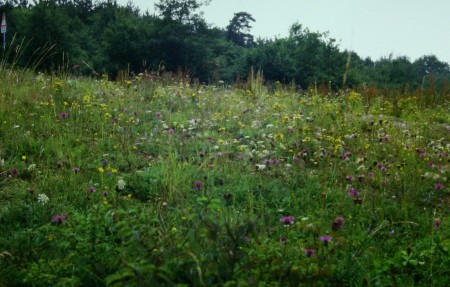 99/26, 1984-08-05. Summer meadow with wild flowers on the Stockert.
99/26, 1984-08-05. Summer meadow with wild flowers on the Stockert.
|
 104/25, 1985-06-23. Sage and radio telescope.
104/25, 1985-06-23. Sage and radio telescope.
|
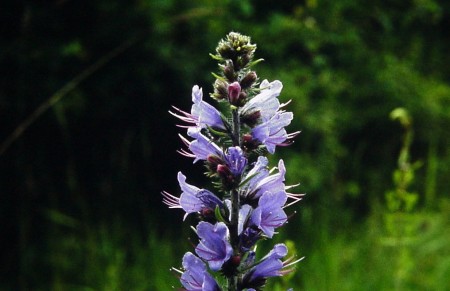 104/28, 1984-08-05. A wild flower on the Stockert.
104/28, 1984-08-05. A wild flower on the Stockert.
|
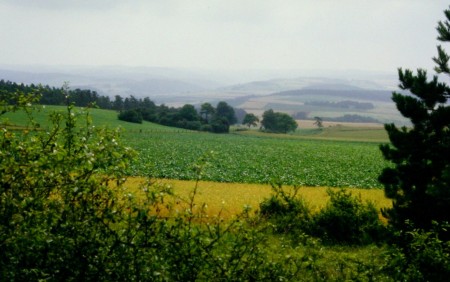 99/23, 1984-08-05. The observatory grounds are surrounded by farm tracks that invite us for a walk. This is the view from the Stockert toward the Southwest.
99/23, 1984-08-05. The observatory grounds are surrounded by farm tracks that invite us for a walk. This is the view from the Stockert toward the Southwest.
|
 99/24, 1984-08-05. The observatory grounds are surrounded by farm tracks that invite us for a walk. At this point it is possible to peek over the fence and see the two telescopes.
99/24, 1984-08-05. The observatory grounds are surrounded by farm tracks that invite us for a walk. At this point it is possible to peek over the fence and see the two telescopes.
|
 99/25, 1984-08-05. The observatory grounds are surrounded by farm tracks that invite us for a walk. This is the view north toward the Kalkkuppen (limestone domes).
99/25, 1984-08-05. The observatory grounds are surrounded by farm tracks that invite us for a walk. This is the view north toward the Kalkkuppen (limestone domes).
|
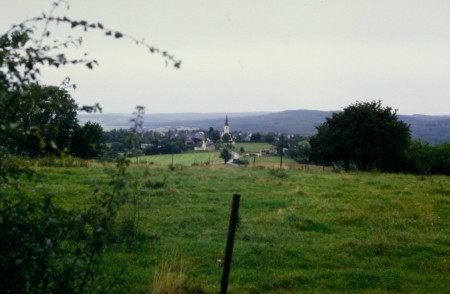 102/S, 1984-09-23. Directly below the Stockert is the village of Eschweiler.
102/S, 1984-09-23. Directly below the Stockert is the village of Eschweiler.
|
 101/18, 1985-05-27. Located at the summit of the Stockert, the radio telescope is visible from a large distance. This picture was taken from the Hartenberg, 5 km east of the Stockert. The 10 metre dish also just visible in the clearing of the forest.
101/18, 1985-05-27. Located at the summit of the Stockert, the radio telescope is visible from a large distance. This picture was taken from the Hartenberg, 5 km east of the Stockert. The 10 metre dish also just visible in the clearing of the forest.
|
 104/09, 1985-05-27. The Stockert (left) and Hirnberg (right) as seen from the Jakop-Kneip-Berg, 4 km southwest of the Stockert.
104/09, 1985-05-27. The Stockert (left) and Hirnberg (right) as seen from the Jakop-Kneip-Berg, 4 km southwest of the Stockert.
|
 104/24, 1985-06-23. The road from the left and uphill leads past the Sonnenhaus ("house of the Sun", control building for the 10 metre dish for solar observations) to the 25 metre main telescope. In this picture the guest house - with space for half a dozen or more observers and technicians - is behind us and a regular house is beyond the right edge of the frame. This picture reminds me of the melancholy, when I would tiredly crawl out of bed just before midday. Often the weather would not be as clear as the evening before, and a day's work in Bonn would lie ahead.
104/24, 1985-06-23. The road from the left and uphill leads past the Sonnenhaus ("house of the Sun", control building for the 10 metre dish for solar observations) to the 25 metre main telescope. In this picture the guest house - with space for half a dozen or more observers and technicians - is behind us and a regular house is beyond the right edge of the frame. This picture reminds me of the melancholy, when I would tiredly crawl out of bed just before midday. Often the weather would not be as clear as the evening before, and a day's work in Bonn would lie ahead.
|
 104/27, 1985-06-23. This view from the platform behind the 25 metre dish shows the Sonnenhaus ("house of the Sun") and the 10 metre dish. The Sonnenhaus was the control building for the 10 metre telescope, which was used to observe the Sun.
104/27, 1985-06-23. This view from the platform behind the 25 metre dish shows the Sonnenhaus ("house of the Sun") and the 10 metre dish. The Sonnenhaus was the control building for the 10 metre telescope, which was used to observe the Sun.
|
 104/29, 1985-06-23. The 25 metre telescope from an unusual angle.
104/29, 1985-06-23. The 25 metre telescope from an unusual angle.
|
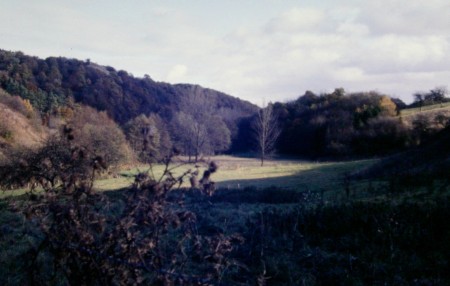 109/16, 1985-11-10. Below the southern slope of the Stockert, toward the Hirnberg, flows the Eschweiler Bach. This valley offers a beautiful, longer walk.
109/16, 1985-11-10. Below the southern slope of the Stockert, toward the Hirnberg, flows the Eschweiler Bach. This valley offers a beautiful, longer walk.
|
 109/17, 1985-11-10. Below the southern slope of the Stockert, toward the Hirnberg, flows the Eschweiler Bach. This valley offers a beautiful, longer walk.
109/17, 1985-11-10. Below the southern slope of the Stockert, toward the Hirnberg, flows the Eschweiler Bach. This valley offers a beautiful, longer walk.
|
 109/18, 1985-11-10. Below the southern slope of the Stockert, toward the Hirnberg, flows the Eschweiler Bach. This valley offers a beautiful, longer walk.
109/18, 1985-11-10. Below the southern slope of the Stockert, toward the Hirnberg, flows the Eschweiler Bach. This valley offers a beautiful, longer walk.
|
 109/19, 1985-11-10. Below the southern slope of the Stockert, toward the Hirnberg, flows the Eschweiler Bach. This valley offers a beautiful, longer walk.
109/19, 1985-11-10. Below the southern slope of the Stockert, toward the Hirnberg, flows the Eschweiler Bach. This valley offers a beautiful, longer walk.
|
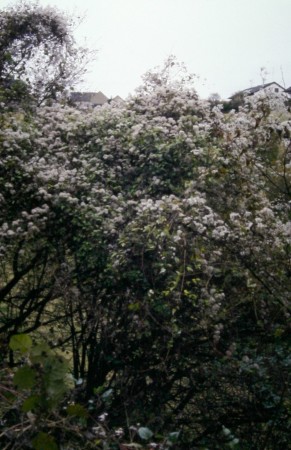 109/20, 1985-11-10. Below the southern slope of the Stockert, toward the Hirnberg, flows the Eschweiler Bach. This valley offers a beautiful, longer walk.
109/20, 1985-11-10. Below the southern slope of the Stockert, toward the Hirnberg, flows the Eschweiler Bach. This valley offers a beautiful, longer walk.
|
 105/57, 1985-09-21. Sundog: Ice crystals in high altitude clouds reflect the different colours of white sunlight in different directions.
105/57, 1985-09-21. Sundog: Ice crystals in high altitude clouds reflect the different colours of white sunlight in different directions.
|
 105/59, 1985-09-21. Rainbow: Raindrops in direct sunlight refract the different colours of white sunlight in different directions.
105/59, 1985-09-21. Rainbow: Raindrops in direct sunlight refract the different colours of white sunlight in different directions.
|
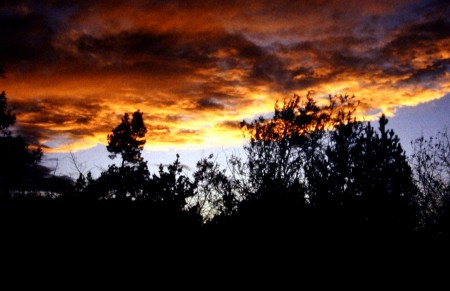 109/15, 1985-11-09. Evening twilight.
109/15, 1985-11-09. Evening twilight.
|
 109/21, 1985/86. Frost.
109/21, 1985/86. Frost.
|
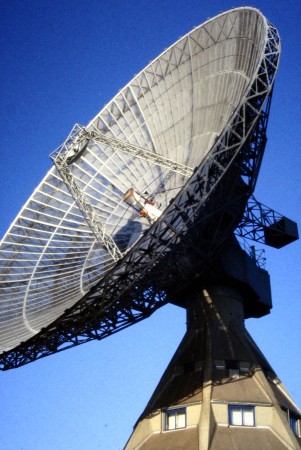 109/22, 1985/86. The Sun starts to melt the frost in the dish.
109/22, 1985/86. The Sun starts to melt the frost in the dish.
|
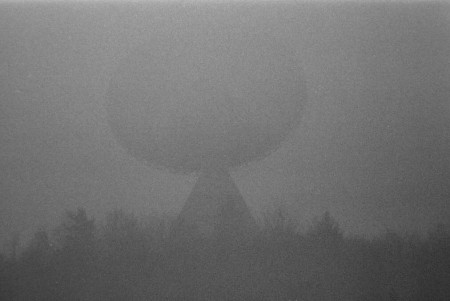 106/13, 1986-02. Although our observations require good weather (and take place at night), the Sun does not always shine the next day.
106/13, 1986-02. Although our observations require good weather (and take place at night), the Sun does not always shine the next day.
|
 109/33, 1986-02/03. The 10 metre dish in a snowy landscape.
109/33, 1986-02/03. The 10 metre dish in a snowy landscape.
|
|
















































